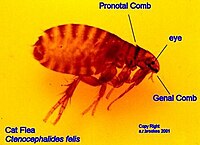Fleas
Ctenocephalides felis, the Cat Flea
The Cat Flea is the most common and widespread species of flea on earth. Even though it’s name indicates that it’s primary host is the domestic cat, it is also the primary flea found on dogs. These small, flat pests not only bite and irritate our pets but us humans as well. A Cat Flea has the ability to jump laterally 7 inches and horizontally up to about 16 inches. The female flea can lay eggs 48 hours after biting it’s host. The eggs are laid on the host but once dry, fall off, usually, onto the host’s bedding or resting area. The eggs hatch into larvae. The larvae then feeds off of the adult Flea feces (consisting of mostly dried blood) that falls of of the host. Next, the larvae will spin a cocoon and begin their pupal stage. The new flea will not emerge from it’s cocoon unless it senses a host near by either through warmth or vibration. Within seconds of hatching, the new flea is jumping for it’s host and within minutes, feeding off of it. Newly hatched adults can only survive for about a week without a food source. Adults that have yet to hatch can live for several months without feeding. Fleas do, however, require humidity to complete their life cycle.
Here is a great web site regarding symptoms & treatment of fleas:


